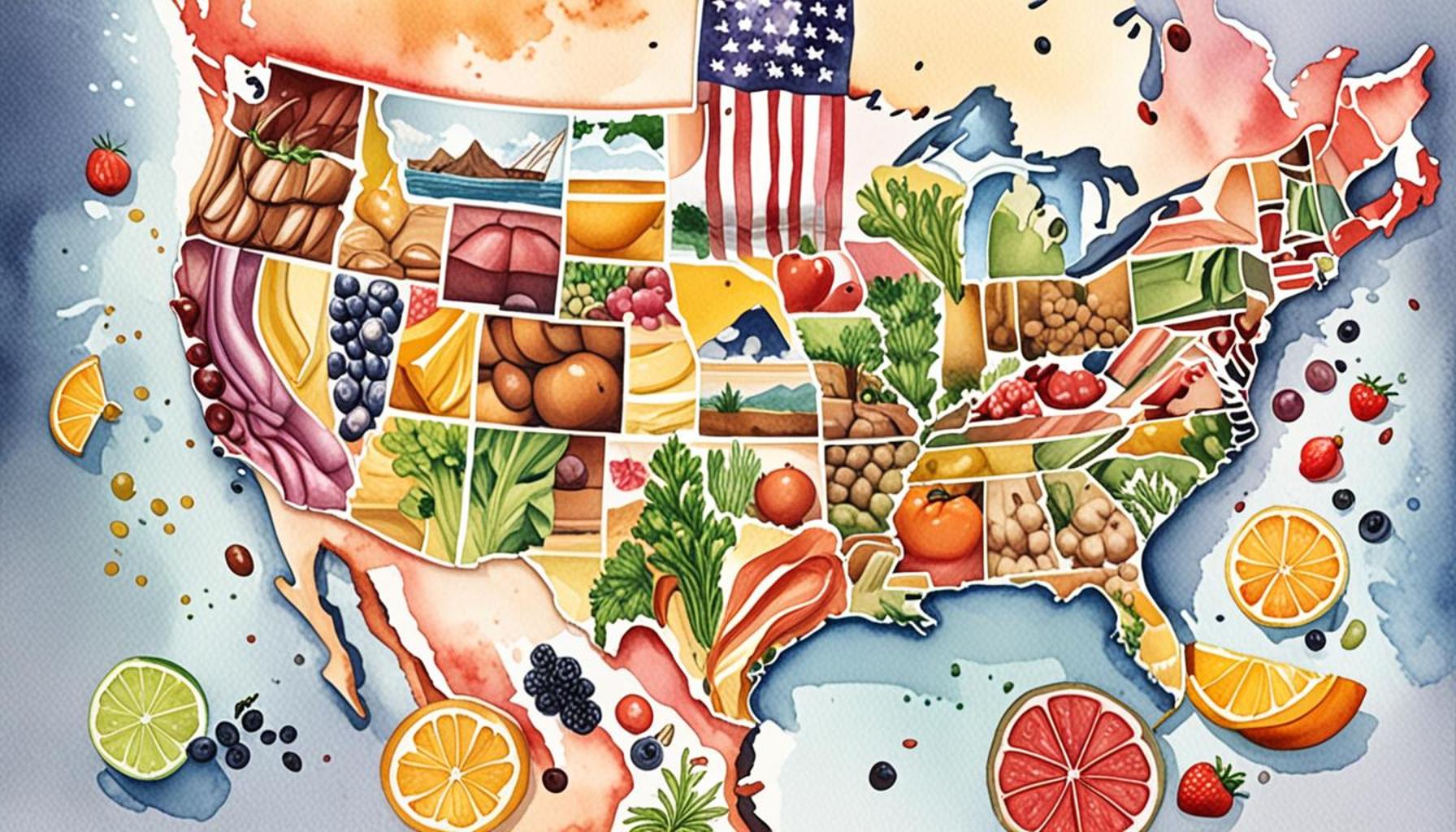The Story Behind the Dishes: Culinary Itineraries that Reveal the Cultural Roots of American Regional Cuisines

A Deep Dive into America’s Food Heritage
Every culinary creation serves as a canvas painted with the vibrant colors of history and culture. The regional cuisines of America exemplify the rich convergence of tastes and practices that have emerged from its complex past. From the robust and spicy gumbo of Louisiana, which showcases the influences of African, French, and Spanish cuisines, to the creamy, comforting clam chowder of New England, these dishes encapsulate the stories and traditions that are interwoven into the fabric of American society.
Southern BBQ: A Legacy of Flavor
One cannot discuss American cuisine without mentioning Southern BBQ. Originating from the methods of cooking employed by Native Americans and adapted by enslaved Africans and European settlers, Southern BBQ is more than just food; it’s a cultural celebration. Regions like Texas, North Carolina, and Kansas City have developed their distinctive styles, with techniques ranging from slow smoking of meats to tangy vinegar-based sauces. The communal nature of BBQ—often held as a social event—further amplifies its role in the Southern identity. Attending a local BBQ festival not only tantalizes the taste buds but immerses one in the vibrancy of Southern hospitality and tradition.
New Mexican Enchiladas: A Culinary Fusion
Traveling west, New Mexican Enchiladas illustrate a profound blend of Spanish, Native American, and Mexican influences. Traditionally made with tortillas filled with cheese, meat, or beans and topped with red or green chile sauce, these enchiladas tell a story of adaptation and survival, rooted deeply in the agricultural practices of Indigenous communities. The famous Hatch green chiles bring a unique, smoky heat that is emblematic of the region, inviting enthusiasts to explore local farms and markets where these prized ingredients are cultivated. Exploring New Mexican cuisine can lead to discussions about cultural preservation and the significance of land in shaping culinary traditions.
Pacific Northwest Salmon: A Connection to Nature
The Pacific Northwest presents yet another tapestry of flavors, prominently featuring wild salmon, a staple among Indigenous tribes who have fished these waters for centuries. Local cooking techniques such as smoking and grilling enhance the deep flavors of the fish, while also respecting the environment from which it comes. The region embodies a commitment to sustainability and seasonal cooking, with an emphasis on locally-sourced ingredients. Visiting farmers’ markets or participating in salmon-bake events not only satiates appetites but fosters an appreciation for the ecological balance within the region.
Diving into these culinary itineraries provides much more than just a delightful dining experience; it opens doors to understanding migration patterns, historical trade routes, and the cultural exchanges that have come to define America. By tracing the origins of beloved dishes, we can uncover a rich, multifaceted heritage often overlooked in mainstream narratives.
As we delve deeper into America’s diverse regional cuisines, we not only discover key ingredients and time-honored cooking techniques but also honor the traditions passed down through generations. These culinary journeys beckon us to embrace the stories of the land and its inhabitants, enriching our appreciation for American culture.
Join us in this exploration of delectable dishes that connect people through shared heritage and flavors. Each itinerary holds the promise of adventure and enlightenment, leading to newfound respect for the cultural treasures embedded in American food.
DISCOVER MORE: Click here to tailor your perfect trip
Tracing the Footprints of Cultural Influences
At the heart of America’s regional cuisines lies an intriguing blend of histories, showcasing the interplay of cultures that have shaped the nation from its inception. To truly appreciate these culinary narratives, one must embark on a journey that examines both the ingredients and the techniques that are the telltale signs of their origins. As we explore these diverse culinary itineraries, the common thread of heritage and community ties emerges, emphasizing how food acts as a bridge between peoples and places.
New England’s Baked Beans: A Historical Perspective
No exploration of American chow would be complete without a nod to New England’s iconic baked beans. This dish has roots that stretch back to Native American customs and the early settlers’ experiences. Historically, the Indigenous peoples cultivated various beans and combined them with local ingredients, showcasing a sustainable approach to food. The influence of Puritan settlers, who prized simplicity and nutrition, led to the adaptation of recipes that incorporated molasses and salt pork, transforming baked beans into a hearty staple. Today, they symbolize community gatherings and are often served at family functions and summer barbecues. When you delve into a plate of baked beans, you savor centuries of tradition and celebration.
Midwest Comfort: The Potluck Tradition
Moving to the Midwest, the potluck embodies the essence of community dining. This culinary practice, where friends and neighbors gather to share homemade dishes, speaks volumes about the values of hospitality and generosity. The potluck often features comfort foods like casseroles, jello salads, and baked goods, reflecting the agricultural bounty of the region. The act of sharing not only fills appetites but reinforces social bonds. Engaging in potluck events fosters a connection to the land—each dish telling a story of ingredients sourced from local farms, passed down through generations. This communal approach invites participants to contribute their family favorites, nurturing a sense of belonging.
California’s Farmers’ Markets: A Celebration of Local Diversity
In the vibrant culinary landscape of California, farmers’ markets stand as a testament to the state’s diverse agricultural heritage. The state’s Mediterranean climate allows for a plethora of fruits and vegetables that find their way into the kitchens of home cooks and professional chefs alike. Here, the emphasis is not solely on the ingredients but also on the relationships formed with local farmers and artisans. Culinary enthusiasts flock to these markets for fresh produce, artisanal cheeses, and sustainably-raised meats—ingredients that inspire dishes steeped in the philosophies of farm-to-table dining. The experience of visiting a farmers’ market is not just a shopping trip; it is an immersion in regional identity and a commitment to supporting local economies.
The Flavors of the Southwest: Verde and Rojo
The Southwest is another area rich with flavor, particularly known for its chiles and spices. This region, where Mexican culture intertwines with Native American traditions, showcases culinary masterpieces like green and red enchiladas. The vibrant colors and flavors of these dishes symbolize the convergence of two worlds, each bringing unique techniques and ingredients to the table. The use of local chiles in these dishes not only adds heat but also fosters a deep appreciation for the land where they are grown. Culinary exploration in the Southwest invites individuals to unite in their love for spicy flavors and dive deeper into the history of its vibrant culinary landscape.
As each of these regional cuisines reveals, the roots of American food culture are intricately woven together, forming a rich tapestry of diverse influences. By tracing these culinary paths, individuals can appreciate the stories behind the dishes and the significance they hold in the broader context of American history.
| Advantage | Description |
|---|---|
| Culinary Heritage | Exploration of America’s regional cuisines highlights the diverse cultural influences that have shaped local dishes over centuries. |
| Cultural Connection | Discovery of culinary itineraries fosters a meaningful connection with communities, revealing the stories and traditions behind each dish. |
In the intricate tapestry of American regional cuisines, each dish carries with it a narrative of its origins, deeply rooted in the cultural history of the land. Culinary itineraries not only lead food enthusiasts on a journey through diverse flavors but also unveil the historical significance embedded in meals. For instance, Southern BBQ is more than just a cooking style; it is a rich fusion reflecting African, Native American, and European influences. Excursions into these regional specifics allow travelers to experience the unique ingredients, preparation methods, and local customs that define the culinary landscape.Moreover, the act of savoring local cuisines unveils a deeper understanding of cultural practices and communal lifestyles. As one moves from coast to coast or city to village, the flavors change, offering a palpable connection to the people, their histories, and their heritage. Culinary itineraries thus play a pivotal role in preserving these cultural narratives, prompting travelers to engage with and appreciate the rich mosaic of American culinary identity. These experiences also encourage the locals to share their customs, forging a strong community bond that elevates food beyond mere sustenance—transforming it into an exploration of shared histories and identities.
DISCOVER MORE: Click here to explore sustainable dining options</p
Food as a Narrator of Immigrant Stories
American regional cuisines also serve as a reflection of the nation’s continuous tapestry woven by its immigrant populations. Each wave of newcomers brought their unique culinary traditions, ingredients, and flavors, leading to the birth of new dishes that celebrate diversity and adaptation. A deep dive into these stories not only highlights the role of food but also encapsulates the struggles and triumphs of different communities across the nation.
The Italian Influence: From Pasta to Pizza
The Italian American culinary impact is one of the most significant narratives in American food history. Initially, early Italian immigrants faced cultural barriers in a land that often shunned their traditional foods. However, the community’s uncanny ability to adapt led to the creation of classic dishes like the ever-popular pizza and spaghetti and meatballs. These dishes have transcended their humble origins and are now staples in households across the country. In cities like New York and Chicago, regionally adapted pizza styles showcase how immigrants took local ingredients and merged them with their traditional recipes, resulting in a culinary evolution that speaks to both hardship and innovation. Today, Italian American cuisine not only preserves its roots but also contributes to national identity.
The Southern Comfort: Cajun and Creole Cuisine
Down in the South, the fusion of various cultural influences birthed rich and soulful cuisines such as Cajun and Creole. Originating from the Acadian exiles and influenced by African, Spanish, and Native American traditions, these culinary styles highlight the region’s histories of displacement and adaptation. Dishes like gumbo and jambalaya serve as a canvas for storytelling, using ingredients like rice, andouille sausage, and okra to narrate tales of hard work, celebration, and resilience. At the heart of these dishes is the love for community, often served in large pots during family gatherings and festivals like Mardi Gras, where the flavors are as vibrant as the culture itself.
The Pacific Northwest: A Marine Bounty
The Pacific Northwest holds a unique position within American regional cuisines, characterized by its emphasis on sustainability and locally sourced seafood. The area’s culture has heavily influenced the development of dishes centered around the ocean’s bounty, such as salmon, Dungeness crab, and clam chowder. The region’s indigenous peoples have long relied on these ingredients, and the modern culinary scene continues to honor these traditions through sustainable practices. Restaurants in cities like Seattle and Portland showcase dishes that highlight fresh catches, paired with seasonal vegetables for a holistic farm-to-table experience. This cuisine not only satisfies the palate but also fosters a connection with the land and sea that is crucial to understanding the Pacific Northwest identity.
The Spice Route of the East: Exploring Indian and Asian Influences
The fusion of Indian and Asian flavors in American cuisine reflects the rich history of immigration from these regions. Cities like San Francisco and New York are melting pots for culinary exploration, where dishes like butter chicken and <strong pho have found a permanent place on menus and home tables. The variety of spices used in these cuisines contributes to complex flavor profiles that tell stories of tradition and modernity. Restaurants often serve fusion dishes that marry American comforts with Asian influences, showcasing creativity that mirrors the evolving landscape of American identity. This culinary trajectory invites consumers to embrace new tastes while honoring the traditions of those who brought them to America.
Through these examples, one can see that regional cuisines are not merely collections of recipes; they are vibrant testaments to the cultural adaptations and narratives that shape American society. By investigating the stories behind these dishes, the ever-evolving landscape of American food culture and its profound connections to community and history become evident.
DIVE DEEPER: Click here to discover the best apps for travel itinerary planning
Conclusion: The Culinary Tapestry of America
In exploring the story behind American regional cuisines, we unveil a rich tapestry woven from the threads of diverse cultural influences, historical migrations, and community gatherings. Each dish, from the hearty gumbo of the South to the sophisticated sushi rolls of urban centers, tells a unique story that highlights the resilience and adaptability of immigrant populations. These culinary itineraries not only celebrate the flavors but also honor the experiences and struggles that shaped the American identity.
The journey through food reveals that dishes like pizza, jambalaya, or clam chowder are much more than merely what we eat; they are reflections of cultural heritages, community ties, and shared memories. As we savor these regional specialties, we also partake in a collective narrative that binds us together, offering a greater understanding of our nation’s multifaceted nature.
To truly appreciate the depth of American cuisine, it is essential to dig deeper into the stories behind the dishes we often take for granted. Visiting local eateries, attending cultural festivals, or even experimenting with recipes at home can open up a world of flavors and histories waiting to be explored. In this way, food becomes not only a means of sustenance but also a powerful connector that fosters a sense of belonging and pride in our diverse heritage. Therefore, as we continue to celebrate America’s culinary richness, let us remember that each meal serves as a narrative of culture, identity, and the indomitable spirit of those who came before us.


